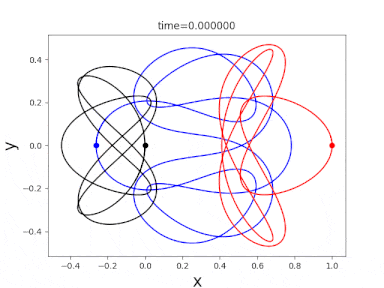The Earth has one moon at about 1/80 of Earth's mass. Is it possible to have two moons large enough each to subtend a >30 minute disk as viewed from the surface?
I have tried with various simulators and systems fail spectacularly within a few dozen orbits, either with one colliding with the planet, or being thrown out of the system.
This question was prompted by many SF novels with covers showing several large moons in the sky.
Preliminary thoughts:
One possibility is to have the two moons co-orbiting each other and the pair orbiting the planet. As long as they are outside Roche's limit this is fairly reasonable. But it is boring. I'm seeking solutions where moons can be in line with the planet either both on one side or planet in the middle.
If we use Luna as the first moon (our present moon) then if we locate Selene (the new one) at half the distance it has to be only half the diameter and 1/8 the mass. This would make it 1/640th the mass of earth. (Because tides go up as inverse cube of the distance, but direct as mass, little Selene would cause about the same size tides as Luna)
Is it easier to make a long term stable system with large differences in mass?
E.g. Earth/Luna is about 80. If we used a similar ratio between Luna and Selene, then Selene has to be just under 1/4 Luna's diameter or about 800 km. To have the same angular diameter it has to be at 1/4 the distance, giving it an orbital period around 10 days.
However I don't know that this condition will work. So far I have been unable to find papers on how constraints on 3 body problems are derived.
Are there resonances that increase stability (negative feedback loop) rather than scramble the eggs?
I've asked this question on Physics Forums, and gotten no good reply.
Comment on 1 answer received so far:
Wikipedia https://en.wikipedia.org/wiki/Trojan_(celestial_body)
As a rule of thumb, the system is likely to be long-lived if m1 > 100m2 > 10,000m3 (in which m1, m2, and m3 are the masses of the star, planet, and trojan).
More formally, in a three-body system with circular orbits, the stability condition is
$27 * (m_1m_2 + m_2m_3 + m_3m_1) <(m_1 + m_2 + m_3)^2$
- So the trojan being a mote of dust, m3→0, imposes a lower bound on
$m_1 \over m_2$ of ${25+\sqrt{621}} \over 2$
≈ 24.9599. And if the star were hyper-massive, m1→+∞, then under Newtonian gravity, the system is stable whatever the planet and trojan masses. And if
${m_1 \over m_2} = {m_2 \over m_3}$
then both must exceed 13+√168 ≈ 25.9615. However, this all assumes a three-body system; once other bodies are introduced, even if distant and small, stability of the system requires even larger ratios.

